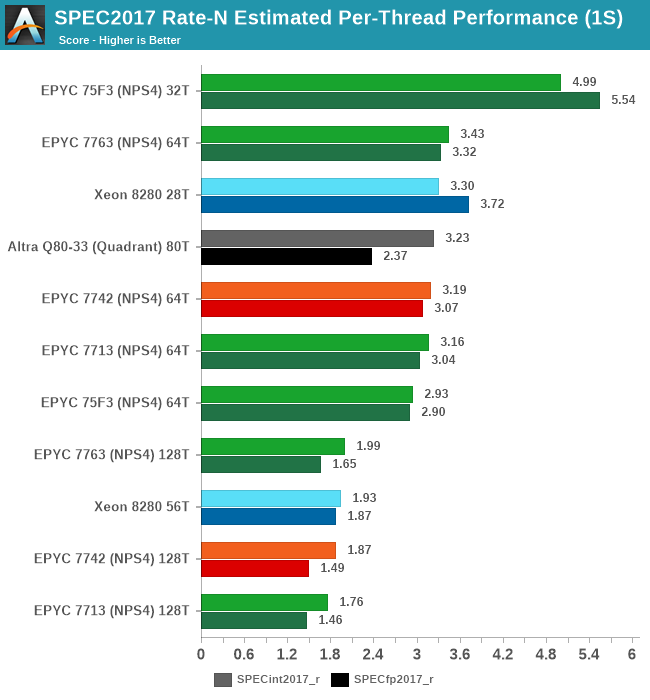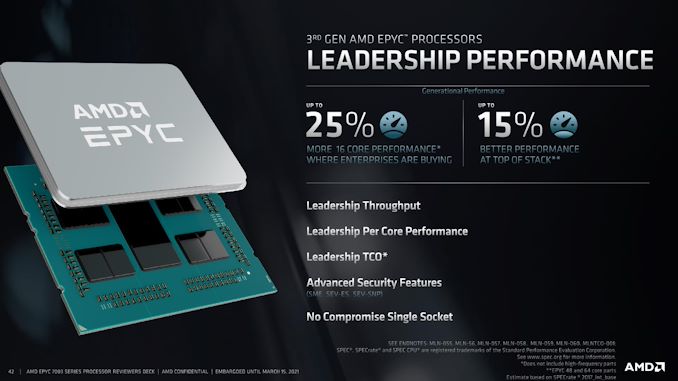AMD 3rd Gen EPYC Milan Review: A Peak vs Per Core Performance Balance
by Dr. Ian Cutress & Andrei Frumusanu on March 15, 2021 11:00 AM ESTDisclaimer June 25th: The benchmark figures in this review have been superseded by our second follow-up Milan review article, where we observe improved performance figures on a production platform compared to AMD’s reference system in this piece.
SPEC - Per-Core Win for "F"-Series 75F3
A metric that is actually more interesting than isolated single-thread performance, is actually per-thread performance in a fully loaded system. This actually is a measurement and benchmark figure that would greatly interest enterprises and customers which are running software or workloads that are possibly licensed on a per-core basis, or simply workloads that require a certain level of per-thread service level agreement in terms of performance.
It’s precisely this market that AMD is trying to target with its new “F”-series of processors, and this is where the new 75F3 comes into play. With 32 cores, 4 cores per chiplet with the full 256MB of L3 cache, and a base frequency of 2.95GHz, boosting up to 4.0GHz at a default 280W TDP, is the chip is squeezing out the maximum per-core performance while still offering a massive amount of multi-threaded performance.

At full load, this ends up with a massive per-thread performance leadership on the part of the 75F3, landing 45% ahead of the 7763 and 51% ahead of the Intel Xeon 8280.
It’s to be noted that limiting the thread count of the higher core-count SKUs will also result in a better per-thread performance metric, for example running a 7713 with only 32 threads will result in a SPECint2017 estimated score of 4.30 – the 75F3 still has a 16% advantage there even though its boost clock is only 8.8% higher at the peak – meaning the 75F3 is achieving higher effective frequencies. Unfortunately, we didn’t have enough time to do the same experiment on the equal 280W 7763 part.
AMD discloses that the biggest generational gains for the Milan stack is found in the lower core-count models, where for example the 7313 and the 7343 outperforms the 7282 and 7302 by 25%. Reason for this is that for example the new 7313 features double the L3 cache, and all the new CPUs are boosting higher with respectively higher TDPs, increasing to 150/190W from 120/155W, as well as landing in at +50% higher price points when comparing generation to generation.











120 Comments
View All Comments
mode_13h - Saturday, March 20, 2021 - link
Okay, thanks for confirming with them.mode_13h - Saturday, March 20, 2021 - link
It's not the easiest thing to confirm with a test, since you'd have to come along behind the writer and observe that a write that SHOULD still be in cache isn't.CBeddoe - Monday, March 15, 2021 - link
I'm excited by AMD's continuing design improvements.Can't wait to see what happens with the next node shrink. Intel has some catching up to do.
Ppietra - Tuesday, March 16, 2021 - link
Can someone please explain how is it possible that the power consumption of the all package is so much higher than the power consumption of the actual cores doing the work?Spunjji - Friday, March 19, 2021 - link
Because the I/O die is running on an older 14nm process and is servicing all of the cores. In a 64-core CPU, the per-core power use of the I/O die is less than 2W. Still too much, of course, but in context not as obscene as it looks when you look at the total power.Elstar - Tuesday, March 16, 2021 - link
Lest it go unsaid, I really appreciate the "compile a big C++ project" benchmark (i.e. LLVM). Thank you!Spunjji - Tuesday, March 16, 2021 - link
"To that end, all we have to compare Milan to is Intel’s Cascade Lake Xeon Scalable platform, which was the same platform we compared Rome to."Says it all, really. Good work AMD, and cheers to the team for the review!
Hifihedgehog - Tuesday, March 16, 2021 - link
Sysadmin: Ram? Rome?AMD: Milan, darling, Milan...
Ivan Argentinski - Tuesday, March 16, 2021 - link
Congrats for going more in-depth for the per-core performance! For many enterprise buyers, this is the most (only?) important metric. I do suspect, that in this regard, the 8 core 72F3 will actually be the best 3rd gen EPYC!But to better understand this, we need more test and per-core comparisons. I would suggest comparing:
* All current AMD fast/frequency optimized CPUs - EPYC 72F3, 73F3, ...
* Previous gen AMD fast/frequency CPUs like EPYC 7F32, ...
* Intel Frequency optimized CPUs like Xeon Gold 6250, 6244, ...
The only metric that matters is per-core performance under full *sustained* load.
Exploring the dynamic TDP of AMD EPYC 3rd gen is also an interesting option. For example, I am quite curious about configuring 72F3 with 200W instead of the default 180W.
Andrei Frumusanu - Saturday, March 20, 2021 - link
If we get more SKUs to test, I'll be sure to do so.